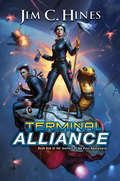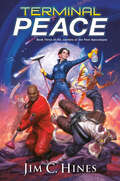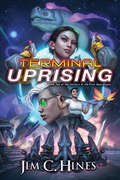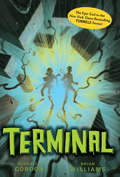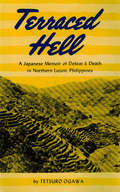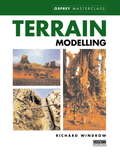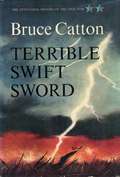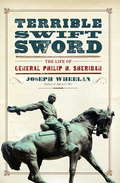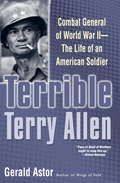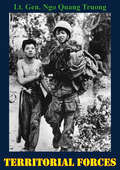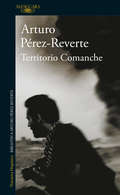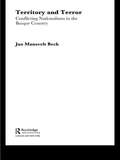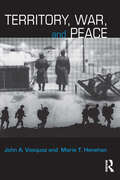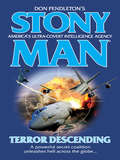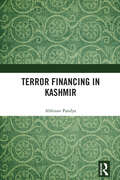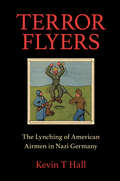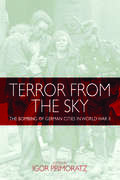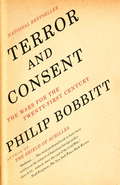- Table View
- List View
Terminal Alliance (Janitors of the Post-Apocalypse #1)
by Jim C. HinesIn his hilarious new sci-fi series, Jim C. Hines introduces the unlikely heroes that may just save the galaxy: a crew of space janitors.The Krakau came to Earth to invite humanity into a growing alliance of sentient species. However, they happened to arrive after a mutated plague wiped out half the planet, turned the rest into shambling, near-unstoppable animals, and basically destroyed human civilization. You know—your standard apocalypse. The Krakau’s first impulse was to turn around and go home. (After all, it’s hard to have diplomatic relations with mindless savages who eat your diplomats.) Their second impulse was to try to fix us. Now, a century later, human beings might not be what they once were, but at least they’re no longer trying to eat everyone. Mostly. Marion “Mops” Adamopoulos is surprisingly bright (for a human). As a Lieutenant on the Earth Mercenary Corps Ship Pufferfish, she’s in charge of the Shipboard Hygiene and Sanitation team. When a bioweapon attack wipes out the Krakau command crew and reverts the rest of the humans to their feral state, only Mops and her team are left with their minds intact.Escaping the attacking aliens—not to mention her shambling crewmates—is only the beginning. Sure, Mops and her team of space janitors and plumbers can clean the ship as well as anyone, but flying the damn thing is another matter. As they struggle to keep the Pufferfish functioning and find a cure for their crew, they stumble onto a conspiracy that could threaten the entire alliance… a conspiracy born from the truth of what happened on Earth all those years ago. Jim C. Hines has proven himself a master of humorous fantasy with his Jig the Goblin novels, and has turned the usual fantasy tropes sideways and upside down with his Princess and his Magic Ex Libris series. With Terminal Alliance, the debut novel in his humorous military science fiction series, Jim takes us into a brand-new universe of entertainment certain to appeal to fans of both Douglas Adams and Terry Pratchett.
Terminal Impact
by Charles HendersonFrom the author of Marine Sniper--the classic true account of Sergeant Carlos Hathcock--comes a gripping and gritty new novel about a sniper on the trail of al-Qaeda terrorist Abu Musab al-Zarqawi in post-9/11 Iraq... At age twenty, Marine Scout-Sniper Jack Valentine had his first kill in Iraq at the start of the Persian Gulf War. Now, it's 2006, and he's back in Baghdad, obsessed with taking down al-Qaeda terrorist Abu Musab al-Zarqawi. Jack missed his first shot at Zarqawi, and it's haunted him ever since--even though the attack struck fear into the black hearts of the jihadists and earned him the name the Ghost of Anbar. Now leading his own special operations platoon, Jack is determined to hunt down and take out his target this time. But the jihadists are not his only enemies. The ruthless amoral leader of a band of mercenaries is feeding al-Qaeda secret information--and also pursuing the love of Jack's life, FBI agent Liberty Cruz. Jack may soon find himself in the crosshairs if he doesn't eliminate his rival first...From the Hardcover edition.
Terminal Peace (Janitors of the Post-Apocalypse #3)
by Jim C. HinesThe third and final book of the Janitors of the Post-Apocalypse follows a group of unlikely heroes trying to save the galaxy from a zombie plague.Marion &“Mops&” Adamopoulos and her team were trained to clean spaceships. They were absolutely not trained to fight an interplanetary war with the xenocidal Prodryans or to make first contact with the Jynx, a race who might not be as primitive as they seem. But if there&’s one lesson Mops and her crew have learned, it&’s that things like &“training&” and &“being remotely qualified&” are overrated. The war is escalating. (This might be Mops&’ fault.) The survival of humanity—those few who weren&’t turned to feral, shambling monsters by an alien plague—as well as the fate of all other non-Prodryans, will depend on what Captain Mops and the crew of the EDFS Pufferfish discover on the ringed planet of Tuxatl. But the Jynx on Tuxatl are fighting a war of their own, and their world&’s long-buried secrets could be more dangerous than the Prodryans. To make matters worse, Mops is starting to feel a little feral herself…
Terminal Uprising (Janitors of the Post-Apocalypse #2)
by Jim C. HinesHuman civilization didn’t just fall. It was pushed. The Krakau came to Earth in the year 2104. By 2105, humanity had been reduced to shambling, feral monsters. In the Krakau’s defense, it was an accident, and a century later, they did come back and try to fix us. Sort of. It’s been four months since Marion “Mops” Adamopoulos learned the truth of that accident. Four months since she and her team of hygiene and sanitation specialists stole the EMCS Pufferfish and stopped a bioterrorism attack against the Krakau homeworld. Four months since she set out to find proof of what really happened on Earth all those years ago. Between trying to protect their secrets and fighting the xenocidal Prodryans, who’ve been escalating their war against everyone who isn’t Prodryan, the Krakau have their tentacles full. Mops’ mission changes when she learns of a secret Krakau laboratory on Earth. A small group under command of Fleet Admiral Belle-Bonne Sage is working to create a new weapon, one that could bring victory over the Prodryans … or drown the galaxy in chaos. To discover the truth, Mops and her rogue cleaning crew will have to do the one thing she fears most: return to Earth, a world overrun by feral apes, wild dogs, savage humans, and worse. (After all, the planet hasn’t been cleaned in a century and a half!) What Mops finds in the filthy ruins of humanity could change everything, assuming she survives long enough to share it. Perhaps humanity isn’t as dead as the galaxy thought.
Terminal: Terminal (Tunnels #6)
by Roderick Gordon Brian WilliamsThe end to end all ends: The epic finale to the NEW YORK TIMES bestselling TUNNELS series!Total Termination of the English: The Styx and their lethal cohorts of Armagi will settle for nothing less. Not even the mighty US military is strong enough to stop the assault!Will and Elliott flee back underground, down to the innards of the Earth first mapped in DEEPER and FREEFALL. With the support of a small team that survived the plague of New Germania, they discover a secret at the site of the three core pyramids. A secret that may explain not only where the Styx came from, but the human race, too. Can Elliott, with her mixed blood, unlock the clues before Earth itself spins out of orbit?All the many threads of the prior TUNNELS books come together in this epic conclusion!
Termination Orders (A Dan Morgan Thriller #1)
by Leo J. MaloneyFrom a Black Ops veteran and author of Deep Cover, a military thriller about a retired CIA agent forced back into action by a lethal conspiracy.Once a trained killer for the CIA, Dan Morgan has built a new life for himself. But when he receives a desperate plea from his former Black Ops partner—reportedly killed in a foreign battle zone—he flies to help. It should be a routine mission, extracting a human asset from the region. But it's not routine; it's an ambush. Now Morgan is running for his life, holding crucial evidence. With his contacts dead and family in danger, Morgan must take on a full-scale conspiracy in the highest echelons of a vast global network that plays by its own rules—when it suits them. For Dan Morgan, it&’s about to come to an end in Washington, D.C., on a national stage, in the crosshairs of a killer…&“A must-read thriller of torture, assassination, and double agents, where nothing is as it seems.&”—Jon Renaud, author of Dereliction of Duty&“A high-powered thriller…tense and terrifying!&”—Hank Phillippi Ryan, USA Today–bestselling author of The First to Lie&“An outstanding thriller that rings with authenticity.&”—John Gilstrap, New York Times – bestselling author of Hellfire
Terms of Engagement (Alpha Squad #2)
by Kylie BrantRevisit a classic tale of romantic suspense by award-winning author Kylie Bryant…Everything about her was a lieHer role in defusing a hostage crisis had blown her cover, and "Lindsay Bradford" knew she had to flee again. But there was one obstacle.Jack Langley.Except her desire for one manWhoever she really was, Jack knew that Lindsay couldn’t run forever. And she couldn’t fight a vengeful killer all alone. Wherever she went, the SWAT cop would be there to protect her. Nothing would stop him--not even the desire that blindsided them, making them vulnerable to a bullet that now had both their names on it.Originally published in 2009
Terraced Hell: A Japanese Memoir of Defeat & Death in Northern Luzon, Philippines
by Tetsuro OgawaThis memoir from a Japanese civilian placed with the army in World War II offers a rare glimpse of the Japanese experience and psychology during this desperate time.<P><P>Near the end of World War II , when the Japanese military machine was crushed but still hanging on, thousands of Japanese soldiers and civilians were caught in the backlash of the war in Northern Luzon, the Philippines, where half a million Japanese perished.This is an honest and straightforward account of defeat and death in the Philippines, described by a Japanese teacher who survived the horrible ordeal. "Several things compelled me to write this story," says Ogawa. "Since it was my record of a dangerous and fateful year in my life, I thought I should write an exact account of it for my children, an account which could be passed on to future generations."Ogawa questioned a system which demanded death rather than surrender where defeat was imminent and all hope gone. Constant bombing was their daily fare, along with daring guerrilla raids and incursions of head-hunting tribal Igorots.This illustrated war memoir is intensely interesting, if somewhat gruesome reading, and is a valuable and important contribution to the literature of World War II.
Terrain Modelling
by Richard WindrowThis title helps modellers who wish to display the results of their efforts to the best advantage in a diorama. This book provides detailed information on how to create many different types of terrain; the paints, glues, tools and materials that will be of help to the modeller; and how these can be obtained both in Europe and the USA. Illustrated with some 200 photographs and written by a master of diorama modelling with a lifetime's experience, this book provides the essential and invaluable guide to the materials and techniques needed to create top quality terrain for anywhere from Ancient Rome to the Western Front. (From the Hardcover edition.)
Terrible Swift Sword (American Civil War Trilogy #2)
by Bruce CattonThe second episode in this award-winning trilogy impressively shows how the Union and Confederacy, slowly and inexorably, reconciled themselves to an all-out war—an epic struggle for freedom. In Terrible Swift Sword, Bruce Catton tells the story of the Civil War as never before—of two turning points which changed the scope and meaning of the war. First, he describes how the war slowly but steadily got out of control. This would not be the neat, short, “limited” war both sides had envisioned. And then the author reveals how the sweeping force of all-out conflict changed the war’s purpose, in turning it into a war for human freedom. It was not initially a war against slavery. Instead, this was, Mr. Lincoln kept insisting, a fight to reunite the United States. At first, it was not even much of a fight. Cautious generals; inexperienced, incompetent, or jealous administrators; shortages of good people and supplies; excess of both gloom and optimism, kept each side from swinging into decisive action. As the buildup began, there were maddening delays. The earliest engagements were halting and inconclusive. After these first tests at arms, reputations began to crumble. Buell, Halleck, Beauregard Albert Sidney Johnston. Failed to drive ahead—for reasons good and bad. General McClellan (impaled in these pages on the arrogant words of his letters) captured more imaginations than enemies, and continued to accept serious over estimates of Confederate strength while becoming more and more fatally estranged from his own government.
Terrible Swift Sword: The Life of General Philip H. Sheridan
by Joseph WheelanAlongside Ulysses S. Grant and William Tecumseh Sherman, Philip H. Sheridan is the least known of the triumvirate of generals most responsible for winning the Civil War. Yet, before Sherman's famous march through Georgia, it was General Sheridan who introduced scorched-earth warfare to the South, and it was his Cavalry Corps that compelled Robert E. Lee's surrender at Appomattox Courthouse. Sheridan's innovative cavalry tactics and "total war" strategy became staples of twentieth-century warfare.After the war, Sheridan ruthlessly suppressed the raiding Plains Indians much as he had the Confederates, by killing warriors and burning villages, but he also defended reservation Indians from corrupt agents and contractors. Sheridan, an enthusiastic hunter and conservationist, later ordered the US cavalry to occupy and operate Yellowstone National Park to safeguard it from commercial exploitation.
Terrible Terry Allen (Combat General of World War II--The Life of an American Soldier)
by Gerald AstorTerry de la Mesa Allen’s mother was the daughter of a Spanish officer, and his father was a career U. S. Army officer. Despite this impressive martial heritage, success in the military seemed unlikely for Allen as he failed out of West Point—twice—ultimately gaining his commission through Catholic University’s R. O. T. C. program. In World War I, the young officer commanded an infantry battalion and distinguished himself as a fearless combat leader, personally leading patrols into no-man’s-land. In 1940, with another world war looming, newly appointed army chief of staff Gen. George C. Marshall reached down through the ranks and, ahead of almost a thousand more senior colonels, promoted Patton, Eisenhower, Allen, and other younger officers to brigadier general. For Operation Torch, the invasion of North Africa, Allen, now a two-star general, commanded the Big Red One, the First Infantry Division, spearheading the American attack against the Nazis. Despite a stellar combat record, however, Major General Allen found himself in hot water with the big brass. Allen and his troops had become notorious for their lack of discipline off the battlefield. When Seventh Army commander George Patton was pressed by his deputy Omar Bradley to replace “Terrible Terry” before the invasion of Sicily, he demurred, favoring Allen’s success in combat. At the end of the Sicily campaign, with Allen’s protector Patton out of the way (relieved for slapping a soldier), Omar Bradley fired Allen and sent him packing back to the States, seemingly in terminal disgrace. Once again, however, George Marshall reached down and in October 1944, Terrible Terry was given command of another infantry division, the 104th Timberwolves and took it into heavy combat in Belgium. Hard fighting continued as Allen’s division spearheaded the U. S. First Army’s advance across Germany. On 26 April 1945, Terrible Terry Allen’s hard-charging Timberwolves became the first American outfit to link up with the Soviet Union’s Red Army. Terrible Terry Allen was one of the most remarkable American soldiers of World War II or any war. Hard bitten, profane, and combative, Allen disdained the “book,” but he knew how to wage war. He was a master of strategy, tactics, weaponry, and, most importantly, soldiers in combat.
Terrible Victory
by Mark ZuehlkeMark Zuehlke is an expert at narrating the history of life on the battlefield for the Canadian army during World War II. In Terrible Victory, he provides a soldiers-eye-view account of Canada's bloody liberation of western Holland. Readers are there as soldiers fight in the muddy quagmire, enduring a battle that lasted three weeks and in which 6,000 soldiers perished. Terrible Victory is a powerful story of courage, survival, and skill.
Territorial Forces (Indochina Monographs #4)
by Lt. Gen. Ngo Quang TruongIncludes over 25 maps and illustrationsThis monograph forms part of the Indochina Monograph series written by senior military personnel from the former Army of the Republic of Vietnam who served against the northern communist invasion."A significant aspect of the South Vietnamese counter-insurgency effort was the employment of several differently organized military and paramilitary forces, each in a different role. Among them, the Territorial Forces, which made up more than one half of the total RVNAF strength, deserved particular interest because of their vital role in pacification.Pitted against Communist local force and guerrilla units, the Territorial Forces fought a low-key warfare of their own at the grass roots level far removed from the war's limelight. Their exploits were rarely sung, their shortcomings often unjustly criticized. But without their contributions, pacification could hardly have succeeded as it did.To evaluate the performance of the Territorial Forces, this monograph seeks to present the Vietnamese point of view on their roles and missions, development, training, employment, and support as they evolved during the war. More emphatically, it also attempts to analyze their problems and to determine if, in their actual condition, the Territorial Forces were effective enough as antithesis to Communist insurgency warfare." -Author's Preface.
Territorial Revisionism and the Allies of Germany in the Second World War
by Stefan Dyroff Marina Cattaruzza Dieter LangewiescheA few years after the Nazis came to power in Germany, an alliance of states and nationalistic movements formed, revolving around the German axis. That alliance, the states involved, and the interplay between their territorial aims and those of Germany during the interwar period and World War II are at the core of this volume. This "territorial revisionism" came to include all manner of political and military measures that attempted to change existing borders. Taking into account not just interethnic relations but also the motivations of states and nationalizing ethnocratic ruling elites, this volume reconceptualizes the history of East Central Europe during World War II. In so doing, it presents a clearer understanding of some of the central topics in the history of the war itself and offers an alternative to standard German accounts of the period and East European national histories.
Territorio Comanche
by Arturo Pérez-ReverteGuerra de Bosnia, principios de los años noventa. Una novela extraordinaria que es, además, una lúcida reflexión sobre el periodismo «Para un reportero en una guerra, territorio comanche es el lugar donde el instinto dice que pares el coche y des media vuelta; donde siempre parece a punto de anochecer y caminas pegado a las paredes, hacia los tiros que suenan a lo lejos, mientras escuchas el ruido de tus pasos sobre los cristales rotos. El suelo de las guerras está siempre cubierto de cristales rotos. Territorio comanche es allí donde los oyes crujir bajo tus botas, y aunque no ves a nadie sabes que te están mirando.» Esta novela fue llevada al cine por Gerardo Herrero y protagonizada por Imanol Arias y Carmelo Gómez.
Territory and Terror: Conflicting Nationalisms in the Basque Country (Routledge Advances in European Politics #Vol. 25)
by Jan Mansvelt BeckAll Basque interpretations of national power have resulted in an uneasy mix of often fragmented and conflicting territorial identifications. Basques can identify themselves with France, Spain or an imagined Basque nation state. Territory and Terror confronts the imagined and actual territorial dimensions of nationalism, shedding new light on the Basque conflict. The study provides a rich description of territoriality analysed from a comparative perspective and explores the relation between territoriality and regional differences in conflict intensity. It supplies an account of the oft-overlooked internal struggles between Basques, arguing that overestimation of Basque nationalism as the ideological force behind the conflict often leads to a disregard of the identification of many with France or Spain. In addition, the author investigates the conflicts between Basque nationalists themselves over key issues such as terrorist activity. Territory and Terror will appeal to students and researchers of nationalism and territoriality, in particular to those with an interest in the Basque country.
Territory of Lies: The American Who Spied on His Country for Israel and How He Was Betrayed
by Wolf BlitzerBased on exclusive access to the convicted spy and his family, here for the first time is the complete tragic story of Jonathan Jay Pollard, an American Jew working in Naval Intelligence and spying for Israel. Pollard was caught in 1985 after passing thousands of top-secret documents to Israel out of concern for its security. In his affidavit to the judge who sentenced Pollard to life for espionage, then-Secretary of Defense Caspar Weinberger wrote. "It is difficult for me to conceive of a greater harm to national security than that caused by the defendant in view of the breadth, the critical importance to the United States, and the high sensitivity of information he sold to Israel." Drawing on in-depth interviews with Pollard in prison and with members of his family as well as with high-level sources in the US. and Israeli governments, Wolf Blitzer, The Jerusalem Post's Washington Bureau Chief, sought and found answers to many of the troubling questions that continue to make the Pollard affair a matter of concern. Why did Jonathan Pollard spy for the Israelis? Why did he take money from them if his motives were pure? Did he damage U.S. national security? How vital to Israel were the documents he gave them? Why did the Israelis need a spy in Washington? Why did they betray Pollard by handing him over to the FBI and then cooperating with the US. investigation? Did Pollard work alone or are there more Israeli spies in our government? How involved was his wife, Anne, in his spying, and did she deserve a five-year sentence? Did Pollard deserve a life term?
Territory, War, and Peace
by John A. Vasquez Marie T. HenehanThis book presents a collection of new and updated essays on what has come to be known as the territorial explanation of war.The book argues that a key both to peace and to war lies in understanding the role territory plays as a source of conflict and inter-group violence. Of all the issues that spark conflict, territorial disputes have the highest probability of escalating to war. War, however, is hardly inevitable; much depends on how territorial issues are handled. More importantly, settling territorial disputes and establishing mutually recognized boundaries can produce long periods of peace between neighbors, even if other salient issues arise. While territory is not the only cause of war and wars arise from other issues, territory is one of the main causes of war, and learning how to manage it, can, in principle, eliminate an entire class of wars. This book will be of great interest to all students of war and conflict studies, causes of war and peace, international security and strategic studies.John A. Vasquez is Thomas B. Mackie Scholar in International Relations at the University of Illinois, Urbana-Champaign. He is author of The Steps to War (2008) (with Paul Senese) and The War Puzzle Revisited (2009). He has been president of the Peace Science Society (International) and the International Studies Association.Marie T. Henehan is Director of Internships and Lecturer, Department of Political Science at the University of Illinois, Urbana-Champaign. She is author of Foreign Policy and Congress: An International Relations Perspective and co-editor of The Scientific Study of Peace and War.
Terror Descending
by Don PendletonWhen time has run out, when there are no choices left and the government's hands are tied, the Oval Office has one last bid for action: Stony Man. A last-resort, covert action team, this elite commando and cybernetics defense unit swings into action to protect America and the rest of the free world from the nightmare point of no return. Dedicated to a cause thirty years in the making, a powerful, militant group has amassed a private army of weaponry and mercenaries, and a mandate of world peace--by way of mass murder. Across the globe, unmarked planes are spilling a tidal wave of innocent blood as military and civilian targets all become fair game. When enough of the world is gone. . . they will step into power. Unless freedom's last, longest. . . and only shot does what it does best: the impossible.
Terror Financing in Kashmir
by Abhinav PandyaThis book analyses the layered and complex web of terror financing in Kashmir. It examines the role of multiple actors — including formal and informal, state and non-state, profit and non-profit, and local and international — to delineate the various strands of an intricate financial system. It shows how, over time, these sophisticated networks have largely remained elusive to Indian counter-terrorism agencies and the need for a specialised and focused effort to understand it. Drawing on interviews with confidential sources within terror networks, as well as inputs and intel from security agencies on the ground, the author lays the groundwork for a robust counter-terrorism strategy in Kashmir. This book will be a must read for professionals and researchers in security studies, military and strategic studies, politics and international relations, and South Asian studies.
Terror Financing in Kashmir
by Abhinav PandyaThis book analyses the layered and complex web of terror financing in Kashmir. It examines the role of multiple actors — including formal and informal, state and non-state, profit and non-profit, and local and international — to delineate the various strands of an intricate financial system. It shows how, over time, these sophisticated networks have largely remained elusive to Indian counter-terrorism agencies and the need for a specialised and focused effort to understand it.Drawing on interviews with confidential sources within terror networks, as well as inputs and intel from security agencies on the ground, the author lays the groundwork for a robust counter-terrorism strategy in Kashmir. This book will be a must read for professionals and researchers in security studies, military and strategic studies, politics and international relations, and South Asian studies.
Terror Flyers: The Lynching of American Airmen in Nazi Germany
by Kevin T HallTerror Flyers examines the "lynch justice" (Lynchjustiz) committed against American airmen in Nazi Germany during World War II. Using engaging first-person accounts of downed pilots, as well as previously unused primary sources, Terror Flyers challenges the notion that such lynchings were exclusively the domain of Nazi party officials and soldiers. New evidence reveals ordinary German people executed Lynchjustiz as well. Initially occurring as a spontaneous reaction to the devastation of the Allied air campaign against the cities of the Third Reich, Lynchjustiz offered the Nazi regime a unique propaganda opportunity to harness the outrage of the German population. Fueled by inspiration from America's own history of the lynching of African Americans, Nazi propaganda exploited the very same imagery found in US publications to escalate the anger of the German people.Drawing heavily on the accounts of the downed airmen themselves, testimonies from the "flyer trials" held in Dachau during 1945–48, and rarely seen Nazi propaganda, Terror Flyers offers a new narrative of this previously overlooked aspect of the Allied campaign in Europe and suggests that at least 3,000 cases of lynch justice likely occurred between 1943 and 1945.
Terror From the Sky
by Igor PrimoratzIn this first interdisciplinary study of this contentious subject, leading experts in politics, history, and philosophy examine the complex aspects of the terror bombing of German cities during World War II. The contributors address the decision to embark on the bombing campaign, the moral issues raised by the bombing, and the main stages of the campaign and its effects on German civilians as well as on Germany's war effort. The book places the bombing campaign within the context of the history of air warfare, presenting the bombing as the first stage of the particular type of state terrorism that led to Hiroshima and Nagasaki and brought about the Cold War era "balance of terror." In doing so, it makes an important contribution to current debates about terrorism. It also analyzes the public debate in Germany about the historical, moral, and political significance of the deliberate killing of up to 600,000 German civilians by the British and American air forces. This pioneering collaboration provides a platform for a wide range of views-some of which are controversial-on a highly topical, painful, and morally challenging subject.
Terror and Consent: The Wars for the Twenty-first Century
by Philip Bobbitt'A masterpiece and manual for our times ... Philip Bobbitt has drawn nothing less than a philosophical route-map for the war on terror and the geopolitical crises of the early 21st century' Matthew d'Ancona, Spectator. 'One of the most important books you are likely to read ... written with remarkable literary grace ... Bobbitt's work is in a class rather apart' Rowan Williams, Daily Telegraph. Almost every widely held idea we have about the war on terror is wrong, Philip Bobbitt argues, and must be rethought. It is not about religion, nationalism or a 'clash of civilizations'. Instead, we face the death of the nation-state and the birth of frontierless, globally networked 'states of terror' that seek to undermine an entire culture of political consent. This dramatic and highly acclaimed book tears down our assumptions to show that we are fighting a new kind of war - and how it can be won. 'The most important exploration of the changing relationship between war and terrorism to date. If you want to know what we will be debating in the coming years, read Bobbitt' John Gray. 'Sets out with clarity and courage the first really comprehensive analysis of the struggle against terror' Tony Blair. 'Bold new ideas ... fascinating ... his analysis goes to the heart of how we think about the structure of the modern world ... an extraordinary book' Rebecca Seal, Observer.
